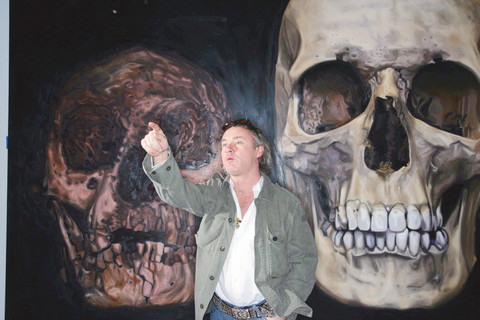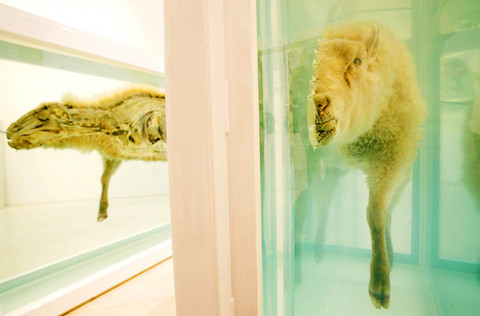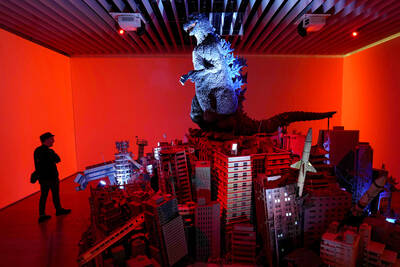In this vast Gloucestershire flatland dotted with abandoned airplane hangars, a former Royal Air Force Station where pilots once plotted classified missions during World War II, the artist Damien Hirst was overseeing a secret operation of his own one recent morning.
It was a delicate undertaking, one that required rubberized protective jumpsuits, long tables of medical equipment and more than 848 liters of formaldehyde. The goal: to replace the decaying tiger shark that floats in one of Hirst's best-known works of Conceptual art, The Physical Impossibility of Death in the Mind of Someone Living.
As rap music quietly played in the background, five men and one woman wearing bright yellow suits, black rubber gloves and breathing masks huddled over the shark's hulking 3.9m replacement. The immediate impression was that the shark was being treated by a team of acupuncturists: some 200 large needles dotted its body.

PHOTOS: NY TIMES NEWS SERVICE
So toxic was the air that the property could be reached only through security-coded iron gates, and no one, not even the artist, was allowed near the shark without protective gear. As Hirst, 41, looked on, he plucked a long hypodermic needle from a nearby worktable.
“Three different lengths of needles are being used to inject the shark with formaldehyde,” he said proudly, with the air of a child showing off a new toy. He flexed the syringe to demonstrate how the needles are inserted into the animal twice, each time penetrating deeper into the body cavity. “The last shark was never injected, so it decayed from the inside.”
The original shark — a 4.2m that was caught and killed by a fisherman in Australia at Hirst's behest in 1991 — was first unveiled to the public in its glass tank the following year at the Saatchi Gallery in London. It quickly became a symbol of the shock tactics common to the circle known as the Young British Artists.

Charles Saatchi, the advertising magnate and collector, had commissioned Hirst to make the work for £50,000 pounds, now about US$95,000. At the time that sum was considered so enormous that the British tabloid the Sun heralded the transaction with the headline “50,000 for Fish Without Chips.”
Botched job
But as a result of inadequate preservation efforts, time was not kind to the original, which slowly decomposed until its form changed, its skin grew deeply wrinkled, and the solution in the tank turned murky. (It didn't help that the Saatchi Gallery added bleach to the solution, hastening the decay, staff members at Hirst's studio claimed.) In 1993, Saatchi's curators finally had the shark skinned and stretched the skin over a fiberglass mold.
“It didn't look as frightening,” Hirst recalled. “You could tell it wasn't real. It had no weight.”
In recent years, Saatchi has been selling off works by the Young British Artists that he collected so voraciously in the 1990s, and two years ago The Physical Impossibility of Death in the Mind of Someone Living was purchased by the hedge fund billionaire Steven A. Cohen, who lives in Greenwich, Connecticut. He paid US$8 million for it, one of the highest prices at the time for a work of contemporary art.
The impetus was a call from Larry Gagosian, the Manhattan dealer, alerting him to Saatchi's intention to sell. Cohen knew the shark's history and its problems: that the piece was never properly injected with formaldehyde, and what was floating in the tank was a fiberglass shadow of its former self. But in a funny way, that too had its appeal.
“Is it real? Isn't it real?” Cohen said. “I liked the whole fear factor.”
But Hirst didn't. When he learned of Cohen's plans to buy the 19.9-tonne work, he volunteered to replace the shark. “I frequently work on things after a collector has them,” the artist said. “I recently called a collector who owns a fly painting because I didn't like the way it looked, so I changed it slightly.”
As it turns out, Cohen is paying for the replacement project, although he declined to say how much it would cost, other than to call the expense “inconsequential.” (The procedure involving the injection of formaldehyde alone adds up to about US$100,000, including labor and materials.)
Hirst began by contacting his shark sources in Australia. And a year ago he bought the second tiger shark, this one from a fisherman who caught it just off the Queensland coast and killed it. It was shipped by sea freighter in a special 6m freezer with backup power, a journey that took roughly two months. Meanwhile, the original tank was being renovated.
Purposely provocative and sometimes disturbing, Hirst is probably Britain's most controversial artist. Lines form around the block at gallery openings of his work, and fans often shout when they recognize him on the street. Some art critics praise him for acquainting a young generation with conceptual art nearly a century after Marcel Duchamp unveiled his porcelain urinal; other critics deride him as an artist of gimmicks and one-liners. In 1995, when he won Britain's prestigious Turner Prize for Mother and Child Divided, a cow and a calf cut into sections and exhibited in a series of vitrines, Brian Sewell of the Evening Standard of London wrote that it was “no more interesting than a stuffed pike over a pub door.”
Hirst has arranged rotting cows to simulate copulation, and displayed sheep preserved in formaldehyde and maggots attacking a cow's head. He has filled glass-fronted shelves with hundreds of bottles and boxes of drugs, displayed dead animals and skeletons in cabinets, and produced canvases covered with real flies and butterflies.
In the airplane hanger where the shark is being worked on — a vast space with several 2.4m-tall freezers filled with dead animals — he continues to explore variations on those themes. Four crucified fiberglass cows, their skins stretched over molds, lie on the floor. Nearby is a table of skulls. Canvases hold the beginnings of what Hirst said would become a series inspired by the Beatles' White Album, which he said he might call Bigger Than God, Yeah, Yeah, Yeah.
A bigger fish to fry
“I've also tried to do a Pieta with cows,” he said, pointing to a marble-edged tank ready to be filled. Nearby is Mr. Potter's Curiosity Museum, a doll's house filled with dead, stuffed animals — rabbits, cats, birds, mice, turtles, frogs — that he bought from a taxidermist in Cornwall.
Reportedly one of the richest men in Britain, Hirst can now afford to run multiple studios in London and in Gloucestershire, some two hours west of the capital, equipped with freezers full of dead animals and emergency generators in case of a power failure.
Such is his reputation that when a 2.1m shark washed up on a beach in July, and the Natural History Museum in London needed a place to store it until its staff was ready to preserve it, the first call it made was to Hirst.
“They asked if I had any room in my freezer,” he said with satisfaction. He was happy to oblige.
Oliver Crimmen, a scientist and fish curator at the Natural History Museum, was in the formaldehyde pool with the shark, directing the operation. Hirst had enlisted his help to ensure that this specimen would last longer than its predecessor. “It's like cookery,” Hirst mused. “There are loads of recipes.”
Crimmen is experienced mainly in preserving fish like giant squid and swordfish. “Normally, the fish I work on are smaller,” he said, “so I have adapted the recipe to the shark's weight, which is 1.92 tonnes. It is critically important to make sure the fluid penetrates all the tissues.”
During a short lunch break over sandwiches and soft drinks, Crimmen explained the procedure. The shark — a female about 25 to 30, middle-aged in shark years — would spend about two weeks in a bath filled with a 7 percent formalin solution, made of dissolved formaldehyde gas and water.
“There are places you cannot reach with needles, like its fin, skull and the spinal column,” Crimmen said. So the shark is immersed in the bath to allow the formaldehyde to be absorbed through the skin. The mission required 34 barrels — each containing 25 liters — of formaldehyde. At night a lid is put over the pool, and the shark is left to marinate.
“You have to have a carefully mapped injection program,” Crimmen said. “There are no nice tests to see if the formaldehyde has been properly absorbed deep inside the shark. You have to see how the specimen behaves to the touch. If it is hard when manipulated and bent, it means it has properly penetrated into the animal's body tissues.”
Unlike most fish, the scientist explained, sharks do not have bony skeletons; theirs are made of cartilage, which is relatively flexible. “Even their jaws, which you might think are made of bone, are actually made of hard cartilage, which has a limited life span and can crumble over time,” Crimmen said. So if the body is to last for decades, the shark must be kept constantly moist in the formalin solution.
A shark's skin is armored with tiny teeth, so Crimmen and his team had to first drill small holes in the skin, filling them with temporary pins in preparation for the injection of the formaldehyde. Because a shark's skin is so rough, the tiny holes won't leave noticeable marks once the fish is properly preserved.
“As a fish curator, I generally preserve things for science and then I don't have to pay attention to aesthetics,” Crimmen said. “This is a novel angle for me.”
After lunch, Crimmen returned to the formaldehyde pool with five workers from Hirst's studio, the rap music still softly playing in the background. Only Crimmen spent the entire day attending to the shark; the environment was so unpleasant, the workers said, that most of them could bear to be there for only a few hours at a time.
By now the shark had been turned on its side and the process of removing the temporary needles and injecting the animal had begun. Once the shark has totally absorbed with the formalin and formaldehyde, it will be taken in a specially designed shark-shaped traveling tank to Bregenz, Austria, for an exhibition that begins in February. (Its original 1991 tank has been refurbished for the occasion.) Sometime in the summer the shark will make its way to Cohen's house in Greenwich.
On a recent Saturday afternoon, Cohen was in Manhattan taking in the latest gallery exhibitions. He had stopped by the Gagosian Gallery on Madison Avenue to see some drawings by Hirst that had just gone on view. On the walls were studies for The Physical Impossibility of Death in the Mind of Someone Living, prompting Cohen to reminisce about the first time he found himself face-to-face with the real piece.
The big dliemma
“It was in County Hall in London,” Cohen said. “I grew up in the generation of Jaws. I knew it was the piece of the 1990s.”
Hirst acknowledges that once the shark is replaced, art historians will argue that the piece cannot be considered the same artwork. “It's a big dilemma,” he said. “Artists and conservators have different opinions about what's important: the original artwork or the original intention. I come from a Conceptual art background, so I think it should be the intention. It's the same piece. But the jury will be out for a long time to come.”
Echoing that argument, Cohen said the shark could not be compared to a painting. “We're dealing with a conceptual idea,” he said. “The whole point is the boldness of the shark. Damien felt strongly that this was the best option.”
Rumors have circulated in the art world that Cohen has promised the work to the Museum of Modern Art. But Cohen said he had made no plans to donate the work to the Modern and that he is unsure exactly where he will put it when the tank arrives in Connecticut.
“Ultimately, I think it's a piece that needs to be put in a major museum,” he said. “I've had discussions with some, but I can't say which ones, and nothing has been decided.”
More generally, his long-term plans include building a private museum on his property in Greenwich to display his art collection, from a Manet self-portrait to Monet's Water Lilies to a Jackson Pollock drip painting to Pop Art by Warhol and Lichtenstein. He also owns Hirst's Away From the Flock, a whole lamb floating in a formaldehyde solution, as well as several paintings by Hirst, among them examples of his signature butterflies, pills and a skull.
As for the future of the new shark, Hirst isn't worried, he said.
“As long as it lasts my lifetime, I'm happy,” he said. After a pause, he added: “It's got a 200-year guarantee. Or your money back.”

Aug. 4 to Aug. 10 When Coca-Cola finally pushed its way into Taiwan’s market in 1968, it allegedly vowed to wipe out its major domestic rival Hey Song within five years. But Hey Song, which began as a manual operation in a family cow shed in 1925, had proven its resilience, surviving numerous setbacks — including the loss of autonomy and nearly all its assets due to the Japanese colonial government’s wartime economic policy. By the 1960s, Hey Song had risen to the top of Taiwan’s beverage industry. This success was driven not only by president Chang Wen-chi’s

Last week, on the heels of the recall election that turned out so badly for Taiwan, came the news that US President Donald Trump had blocked the transit of President William Lai (賴清德) through the US on his way to Latin America. A few days later the international media reported that in June a scheduled visit by Minister of National Defense Wellington Koo (顧立雄) for high level meetings was canceled by the US after China’s President Xi Jinping (習近平) asked Trump to curb US engagement with Taiwan during a June phone call. The cancellation of Lai’s transit was a gaudy

From Godzilla’s fiery atomic breath to post-apocalyptic anime and harrowing depictions of radiation sickness, the influence of the nuclear bombings of Hiroshima and Nagasaki runs deep in Japanese popular culture. In the 80 years since the World War II attacks, stories of destruction and mutation have been fused with fears around natural disasters and, more recently, the Fukushima crisis. Classic manga and anime series Astro Boy is called “Mighty Atom” in Japanese, while city-leveling explosions loom large in other titles such as Akira, Neon Genesis Evangelion and Attack on Titan. “Living through tremendous pain” and overcoming trauma is a recurrent theme in Japan’s

As last month dawned, the Democratic Progressive Party (DPP) was in a good position. The recall campaigns had strong momentum, polling showed many Chinese Nationalist Party (KMT) lawmakers at risk of recall and even the KMT was bracing for losing seats while facing a tsunami of voter fraud investigations. Polling pointed to some of the recalls being a lock for victory. Though in most districts the majority was against recalling their lawmaker, among voters “definitely” planning to vote, there were double-digit margins in favor of recall in at least five districts, with three districts near or above 20 percent in